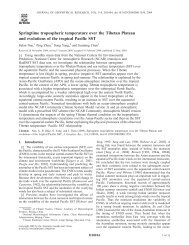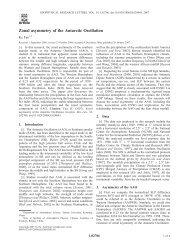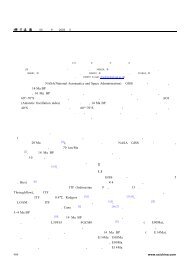Influence of the North Atlantic SST tripole on northwest African rainfall
Influence of the North Atlantic SST tripole on northwest African rainfall
Influence of the North Atlantic SST tripole on northwest African rainfall
You also want an ePaper? Increase the reach of your titles
YUMPU automatically turns print PDFs into web optimized ePapers that Google loves.
LI ET AL.: INFLUENCE OF THE NORTH ATLANTIC <str<strong>on</strong>g>SST</str<strong>on</strong>g> TRIPOLE ACL 3 - 5<br />
Figure 4. Climatological seas<strong>on</strong>al march <str<strong>on</strong>g>of</str<strong>on</strong>g> <strong>northwest</strong> <strong>African</strong> precipitati<strong>on</strong> (mm/day) from (a) <str<strong>on</strong>g>the</str<strong>on</strong>g><br />
GCM c<strong>on</strong>trol run, (b) NCEP/NCAR reanalysis, (c) Xie’s <strong>rainfall</strong> data set, and (d) Humle’s <strong>rainfall</strong> data<br />
set. For comparis<strong>on</strong>, seas<strong>on</strong>al march <str<strong>on</strong>g>of</str<strong>on</strong>g> observed coastal Morocco <strong>rainfall</strong> derived from Lamb and<br />
Peppler [1987] is displayed in (e).<br />
captures <str<strong>on</strong>g>the</str<strong>on</strong>g> main characteristics <str<strong>on</strong>g>of</str<strong>on</strong>g> NW <strong>African</strong> <strong>rainfall</strong>,<br />
thus is appropriate for identifying dry and wet events, to be<br />
used for determining <str<strong>on</strong>g>the</str<strong>on</strong>g> associated large-scale circulati<strong>on</strong>.<br />
3. Observed and Simulated Internal<br />
Variability Associated With NW Africa<br />
Precipitati<strong>on</strong> Anomalies<br />
[16] Here we use composites <str<strong>on</strong>g>of</str<strong>on</strong>g> m<strong>on</strong>ths with extreme<br />
<strong>rainfall</strong> to address whe<str<strong>on</strong>g>the</str<strong>on</strong>g>r our model captures <str<strong>on</strong>g>the</str<strong>on</strong>g> circulati<strong>on</strong><br />
anomalies that are associated with NW <strong>African</strong> <strong>rainfall</strong><br />
in nature. M<strong>on</strong>ths with NW <strong>African</strong> precipitati<strong>on</strong> index 65%<br />
greater or less than its mean value are selected to represent<br />
<str<strong>on</strong>g>the</str<strong>on</strong>g> wettest and driest c<strong>on</strong>diti<strong>on</strong>s. Using this criteri<strong>on</strong>, we<br />
have 26 (28) wet (dry) m<strong>on</strong>ths for early-mid winter and 27<br />
(22) wet (dry) m<strong>on</strong>ths for late winter out <str<strong>on</strong>g>of</str<strong>on</strong>g> <str<strong>on</strong>g>the</str<strong>on</strong>g> 159 earlymid<br />
winter or late winter m<strong>on</strong>ths within <str<strong>on</strong>g>the</str<strong>on</strong>g> reanalysis<br />
period, 1948–2000.<br />
[17] Figure 6 displays composites <str<strong>on</strong>g>of</str<strong>on</strong>g> <str<strong>on</strong>g>the</str<strong>on</strong>g> reanalysis precipitati<strong>on</strong><br />
rate, 500 hPa band-pass streamfuncti<strong>on</strong> variance<br />
(to represent <str<strong>on</strong>g>the</str<strong>on</strong>g> storm track), 500 hPa geopotential height,<br />
and 700 hPa pressure vertical velocity for <str<strong>on</strong>g>the</str<strong>on</strong>g> wettest and<br />
driest m<strong>on</strong>ths during early-mid winter. The band-pass<br />
streamfuncti<strong>on</strong> is calculated from <str<strong>on</strong>g>the</str<strong>on</strong>g> transient comp<strong>on</strong>ents<br />
<str<strong>on</strong>g>of</str<strong>on</strong>g> <str<strong>on</strong>g>the</str<strong>on</strong>g> horiz<strong>on</strong>tal wind, obtained using a 61-point temporal<br />
filter that extracts 3–10 day periods. NW <strong>African</strong> <strong>rainfall</strong><br />
anomalies are associated with large-scale <strong>rainfall</strong> anomalies<br />
across <str<strong>on</strong>g>the</str<strong>on</strong>g> <str<strong>on</strong>g>North</str<strong>on</strong>g> <str<strong>on</strong>g>Atlantic</str<strong>on</strong>g> and Europe. When NW Africa is<br />
wet (Figures 6a, 6c, 6e, and 6g), <str<strong>on</strong>g>the</str<strong>on</strong>g> central <str<strong>on</strong>g>North</str<strong>on</strong>g> <str<strong>on</strong>g>Atlantic</str<strong>on</strong>g><br />
is dry. There are negative 500 hPa height anomalies and<br />
increased synoptic-eddy activity over NW Africa, and<br />
positive height anomalies and reduced synoptic-wave<br />
activity over <str<strong>on</strong>g>the</str<strong>on</strong>g> central <str<strong>on</strong>g>North</str<strong>on</strong>g> <str<strong>on</strong>g>Atlantic</str<strong>on</strong>g>. These anomalies<br />
reflect a southward shift <str<strong>on</strong>g>of</str<strong>on</strong>g> <str<strong>on</strong>g>the</str<strong>on</strong>g> eastern end <str<strong>on</strong>g>of</str<strong>on</strong>g> <str<strong>on</strong>g>the</str<strong>on</strong>g> <str<strong>on</strong>g>North</str<strong>on</strong>g><br />
<str<strong>on</strong>g>Atlantic</str<strong>on</strong>g> stormtrack, which corresp<strong>on</strong>ds to <str<strong>on</strong>g>the</str<strong>on</strong>g> sec<strong>on</strong>d mode<br />
<str<strong>on</strong>g>of</str<strong>on</strong>g> <str<strong>on</strong>g>Atlantic</str<strong>on</strong>g> stormtrack variability described by Rogers<br />
[1997]. When NW Africa is dry, <str<strong>on</strong>g>the</str<strong>on</strong>g> regi<strong>on</strong> <str<strong>on</strong>g>of</str<strong>on</strong>g> reduced<br />
<strong>rainfall</strong> stretches westward and eastward from coastal NW<br />
Africa. Accompanying <str<strong>on</strong>g>the</str<strong>on</strong>g> reduced <strong>rainfall</strong> is a large scale<br />
z<strong>on</strong>al belt <str<strong>on</strong>g>of</str<strong>on</strong>g> enhanced precipitati<strong>on</strong> across <str<strong>on</strong>g>the</str<strong>on</strong>g> nor<str<strong>on</strong>g>the</str<strong>on</strong>g>rn






